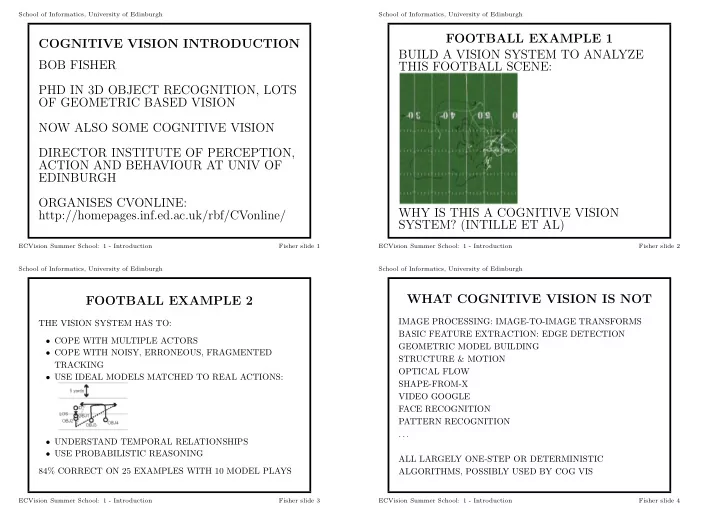

School of Informatics, University of Edinburgh School of Informatics, University of Edinburgh FOOTBALL EXAMPLE 1 COGNITIVE VISION INTRODUCTION BUILD A VISION SYSTEM TO ANALYZE BOB FISHER THIS FOOTBALL SCENE: PHD IN 3D OBJECT RECOGNITION, LOTS OF GEOMETRIC BASED VISION NOW ALSO SOME COGNITIVE VISION DIRECTOR INSTITUTE OF PERCEPTION, ACTION AND BEHAVIOUR AT UNIV OF EDINBURGH ORGANISES CVONLINE: WHY IS THIS A COGNITIVE VISION http://homepages.inf.ed.ac.uk/rbf/CVonline/ SYSTEM? (INTILLE ET AL) ECVision Summer School: 1 - Introduction Fisher slide 1 ECVision Summer School: 1 - Introduction Fisher slide 2 School of Informatics, University of Edinburgh School of Informatics, University of Edinburgh WHAT COGNITIVE VISION IS NOT FOOTBALL EXAMPLE 2 IMAGE PROCESSING: IMAGE-TO-IMAGE TRANSFORMS THE VISION SYSTEM HAS TO: BASIC FEATURE EXTRACTION: EDGE DETECTION • COPE WITH MULTIPLE ACTORS GEOMETRIC MODEL BUILDING • COPE WITH NOISY, ERRONEOUS, FRAGMENTED STRUCTURE & MOTION TRACKING OPTICAL FLOW • USE IDEAL MODELS MATCHED TO REAL ACTIONS: SHAPE-FROM-X VIDEO GOOGLE FACE RECOGNITION PATTERN RECOGNITION . . . • UNDERSTAND TEMPORAL RELATIONSHIPS • USE PROBABILISTIC REASONING ALL LARGELY ONE-STEP OR DETERMINISTIC 84% CORRECT ON 25 EXAMPLES WITH 10 MODEL PLAYS ALGORITHMS, POSSIBLY USED BY COG VIS ECVision Summer School: 1 - Introduction Fisher slide 3 ECVision Summer School: 1 - Introduction Fisher slide 4
School of Informatics, University of Edinburgh School of Informatics, University of Edinburgh SOME COGNITIVE VISION WHAT IS CENTRAL TO COG VIS? APPLICATIONS HYPOTHESIS-BASED: MULTIPLE, RANKED BY PROBABILITY, PRUNING OF COMBINATORIAL INTRUDER/ESCAPING PRISONER DETECTION EXPLOSION ROAD TRAFFIC SURVEILLANCE CITY CENTER SURVEILLANCE HEURISTICS & INCOMPLETE KNOWLEDGE CROWD SAFETY MONITORING PEOPLE DETECTION, LOCALIZATION, COUNTING GENERIC CAPABILITIES: CASE-BASED/RULE-BASED LIP READING, EXPRESSION UNDERSTANDING GESTURE/HAND SIGN RECOGNITION RICH KNOWLEDGE BASED: HUMAN/WORLD/SITUATION SHOPPER ANALYSIS GENERIC OBJECT RECOGNITION TEMPORAL/SEQUENCE ANALYSIS SPORTS VIDEO ANNOTATION CONTEXT BASED IMAGE RETRIEVAL REASONING; ALTERNATIVES, UNCERTAINTY, COPING AERIAL AND GROUND BASED SCENE UNDERSTANDING WITH CHANGE VIDEO ARCHIVE SUMMARIZATION ECVision Summer School: 1 - Introduction Fisher slide 5 ECVision Summer School: 1 - Introduction Fisher slide 6 School of Informatics, University of Edinburgh School of Informatics, University of Edinburgh ECVISION DEFINITION ECVISION DEFINITION CONT. A COGNITIVE VISION SYSTEM CAN ACHIEVE THE FOUR LEVELS OF GENERIC VISUAL FUNCTIONALITY: THIS IS ACHIEVED THROUGH: • DETECTION • LEARNING SEMANTIC KNOWLEDGE (FORM, • LOCALIZATION FUNCTION, & BEHAVIOURS) • RECOGNITION • RETENTION OF KNOWLEDGE (ABOUT THE • UNDERSTANDING (ROLE, CONTEXT, PURPOSE) COGNITIVE SYSTEM, ITS ENVIRONMENT, AND THE RELATIONSHIP WITH THE ENVIRONMENT) AND EXHIBITS PURPOSIVE GOAL-DIRECTED BEHAVIOUR, • DELIBERATION ABOUT OBJECTS AND EVENTS, IS ADAPTIVE TO UNFORESEEN CHANGES, AND CAN INCLUDING THE COGNITIVE SYSTEM ITSELF. ANTICIPATE THE OCCURRENCE OF OBJECTS AND EVENTS. ECVision Summer School: 1 - Introduction Fisher slide 7 ECVision Summer School: 1 - Introduction Fisher slide 8
School of Informatics, University of Edinburgh School of Informatics, University of Edinburgh COG VISION MODEL SYLLABUS 2. Reasoning Technologies 3. Applications/Case Studies http://homepages.inf.ed.ac.uk/rbf/CCVO/cvsyldraft.htm 4. General Resources TOP LEVEL OF HIERARCHY HERE 4. Model Learning 1. Knowledge Representation 1. Overview/Issues 1. Overview/Issues 2. Learning Technologies 2. Knowledge Representation Technologies 3. Applications/Case Studies 3. Applications/Case Studies 4. General Resources 4. General Resources 5. Visual Process Control 2. Recognition, Categorization and Estimation 1. Overview/Issues 1. Overview/Issues 2. Process Control Technologies 2. Recognition Technologies 3. General Resources 3. Applications/Case Studies 6. Good example areas and Case Studies 4. General Resources 1. Static Image Understanding 3. Reasoning about Structures and Events 2. Image Sequence Understanding 1. Overview/Issues ECVision Summer School: 1 - Introduction Fisher slide 9 ECVision Summer School: 1 - Introduction Fisher slide 10 School of Informatics, University of Edinburgh School of Informatics, University of Edinburgh MODEL SYLLABUS II Workshop 2002, 2002. SAMPLE LINK: Many successful single-object tracking algorithms are 1. Knowledge Representation formulated or may be reformulated as Bayesian inference 1. Overview/Issues problem. It is straight-forward to generalize the 1. Style Bayesian formulation to the problem of multi-object 3. Probabilistic tracking. However, due to the increase in dimensionality HAS ONLINE TUTORIAL MATERIALS: this formulation also opens Pandoras box in terms of Internet resources: exponential explosion of the computational complexity. ***Introduction to Bayesian Reasoning*** (Maria Petrou) In this paper we propose to constraint the computational complexity by exploiting and explicitly using prior AND ANNOTATED BIBLIOGRAPHY: knowledge at various levels of the Bayesian formulation Publications: of multi-object tracking. More specifically we discuss Multi-Object Tracking: Explicit Knowledge Representation the use of a knowledge hierarchy which makes explicit and Implementation for Complexity Reduction, where and how to introduce available knowledge. "***Spengler, M. and Schiele, B.***", Cognitive Vision ECVision Summer School: 1 - Introduction Fisher slide 11 ECVision Summer School: 1 - Introduction Fisher slide 12
School of Informatics, University of Edinburgh OVERVIEW OF MY LECTURES 1. DETECTING AND TRACKING MOVING HUMANS 2. MAINTAINING PERSISTENCE WHEN HUMANS TRAJECTORIES OVERLAP 3. IDENTIFYING SHORT-TERM ACTIONS 4. SYNTACTIC REPRESENTING AND RECOGNIZING ACTION 5. PROBABILISTIC REPRESENTING AND RECOGNIZING ACTION ECVision Summer School: 1 - Introduction Fisher slide 13
Recommend
More recommend